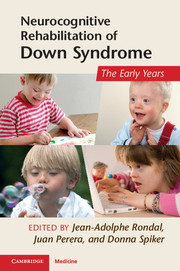Book contents
- Frontmatter
- Contents
- List of contributors
- Preface
- Acknowledgments
- Section 1 Definition, history, methodology, and assessment
- Section 2 Genetics, brain, and animal models
- Section 3 Pharmacological and medical management and treatment
- Section 4 Early development and intervention
- 10 Developmental models as frameworks for early intervention with children with Down syndrome
- 11 Aspects of motor development in Down syndrome
- 12 Memory development and learning
- 13 Prelinguistic and early development, stimulation, and training in children with Down syndrome
- 14 Speech perception, stimulation, and phonological development
- 15 Goal-directedness as a target for early intervention in Down syndrome
- 16 The role of parents of children with Down syndrome and other disabilities in early intervention
- Section 5 Therapeutic perspectives
- Conclusions
- Index
- References
13 - Prelinguistic and early development, stimulation, and training in children with Down syndrome
Published online by Cambridge University Press: 05 July 2011
- Frontmatter
- Contents
- List of contributors
- Preface
- Acknowledgments
- Section 1 Definition, history, methodology, and assessment
- Section 2 Genetics, brain, and animal models
- Section 3 Pharmacological and medical management and treatment
- Section 4 Early development and intervention
- 10 Developmental models as frameworks for early intervention with children with Down syndrome
- 11 Aspects of motor development in Down syndrome
- 12 Memory development and learning
- 13 Prelinguistic and early development, stimulation, and training in children with Down syndrome
- 14 Speech perception, stimulation, and phonological development
- 15 Goal-directedness as a target for early intervention in Down syndrome
- 16 The role of parents of children with Down syndrome and other disabilities in early intervention
- Section 5 Therapeutic perspectives
- Conclusions
- Index
- References
Summary
Language before birth
Language development in typically developing children begins three months before birth. By that time, the auditory system of the fetus/baby is already functional. It is tuned to the speech frequencies (400 to 4000 cycles per second). This is a unique feature of human ontogenesis corresponding to a species-specific predisposition for speech. During the waking periods, every acoustical stimulus exceeding 60 decibels is normally received by the baby's auditory apparatus and treated by the brain. The partial loss of intensity is owing to an energy absorption by the aquatic milieu surrounding the baby and the fact that her/his middle ear is filled with amniotic liquid. As a likely consequence of this exposure, the typically developing baby at birth demonstrates an ability to recognize the mother's voice and individuate it from other voices. This ability is purely prosodic. It relies on the unique tonal and rhythmic characteristics of the mother's voice. This is objectified using the techniques of cognitive–behavioral investigation in neonates (De Boysson-Bardies, 1996). Beyond the particular mother's voice (and through it), typically developing neonates demonstrate an ability to recognize the maternal language (again through its rhythmic characteristics); that is, they can differentiate between the one language that they have been exposed to in utero and other languages (Nazzi et al., 1998).
Young typically developing babies can also differentiate accentuated syllables from non-accentuated ones (Jusczyk et al., 1993). They recognize varied sequences of syllables (Saffran et al., 1996; Marcus et al., 1999).
- Type
- Chapter
- Information
- Neurocognitive Rehabilitation of Down SyndromeEarly Years, pp. 175 - 181Publisher: Cambridge University PressPrint publication year: 2011



